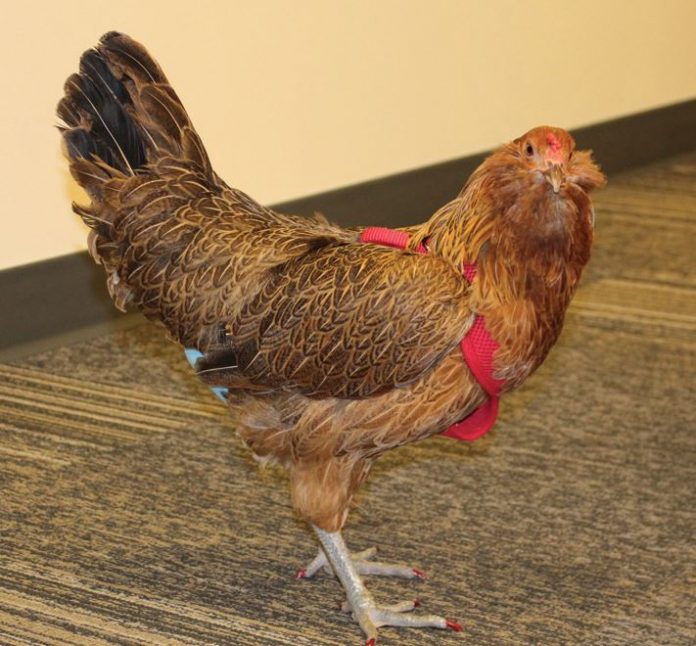
Backyard homesteader Richard Edwords and Imperial Valley chicken expert Cecilia Lizarraga explained the basics of backyard chicken keeping during a recent informal seminar at the Alpine library.
The presentation was part of an ongoing summer series that library staff organized that includes lectures on cheesemaking, beekeeping, vermicomposting, edible landscaping and other topics of interest on backyard homesteading.
“We’ve noticed that people in Alpine have a strong interest in self-sufficiency and DIY projects, so we thought Modern Homesteading would be a fun adult companion to our Teen Maker Camp event series this summer. The response to the series has been very positive, and we hope to continue offering these types of programs in the future,” librarian Jenne Bergstrom said.
Lizarraga kicked off the evening by putting three chickens, Paprika, Oreo and Nutterbutter down to roam free in the resource room of the library and interact with patrons who filled the library resource room at the casual lecture.
Lizarraga explained that the three chickens all run free in her house and illustrated how she affixes a diaper made from a face mask to each of them for cleanliness; she changes the chickens’ diapers three times a day. She also said she has a therapy turkey that she takes to senior care facilities.
In contrast, Edwords talked about two caged chickens, set on a table for the audience to observe, professional egg-layers who hail from Hilliker’s ranch in Lakeside.
Holding a Rhode Island Red Leghorn, Edwords discussed ways to tell whether or not a chicken will be a high egg producer, a layer: legs that are bleached white from calcium that is leached into eggshells, a soft abdomen, and a wide difference between the two legs.
He also discussed the lifespan of a backyard chicken, saying that a layer will generally remain productive until they are about three years old and that ranches generally dispose of them at 18 months.
“It is a very inexpensive hobby and when they get too old you can eat them… just maybe name them something like pork chop,” Edwords said.
He gave a gentle laugh, indicative of a farmer who is comfortable with the reality that backyard homesteading includes a life cycle of productivity.
He also discussed the recent outbreak of Virulent Newcastle disease, a respiratory illness that is deadly to chickens.
According to the USDA, local infected sites have included 142 premises in San Bernardino county 260 in Riverside county, and 45 in Los Angeles county in 2019 so far, prompting officials to keep a watchful eye that the disease does not cross over into San Diego county.
Combating the spread of the disease can prove challenging as it is spread through direct contact of fluids from diseased birds and items such as egg trays and transportation trucks visit different ranches on a regular basis, the perfect means by which the disease can spread.
When chickens are found to be carriers of the disease, they are gassed with CO2 in compliance with the American Veterinary Medical Association standards.
“I have Brakel (chickens), myself; they’re rare and expensive. With the quarantine, it’s scary. They come in and kill all the birds and burn them, destroy everything. It can bankrupt a ranch,” Edwords said.
Turning the audience’s attention back to the lighter side of keeping chickens, Edwords suggested sneaking a few glass eggs in with the regular chicken eggs to combat raccoon encroachment, relating how he watched a couple of invaders at his house take the glass eggs and play with them in his fountain.
He also mentioned that chickens who are no longer laying eggs can be donated to the non-profit rescues Lions, Tigers and Bears or the California Wolf Center, saying that slaughtering an animal is never easy and this way chickens who are past their prime are still going to a good cause.
Lizarraga gave a quick rundown of home remedies that she relies on to treat her fowl companions: apple cider vinegar for sourcrop, garlic as a low-level antibiotic, vitamin B-12 for those who seem sluggish.
“They do get lice, fleas, mites… you have to be very careful with flies and the spread of disease. Food grade diatomaceous earth is great for flea prevention,” Lizarraga said.
Lizarraga and Edwords threw questions to the audience that they could answer in exchange for basic items that could be used in conjunction with keeping chickens, all donated by Tractor Supply,
Edwords ended the night with a reminder that backyard homesteading is part of a local heritage, saying that just about every Western home seen in old pictures includes chickens and that one chicken can feed a family.












